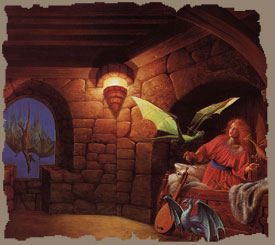Summary
Most of the Dragonriders of Pern books were written by Anne McCaffrey. However, due to her old age she recently handed over the series to her son Todd McCaffrey. The books written earlier have a fantasy slant to them (low levels of technology, firebreathing telepathic dragons, and a feudal society), however McCaffrey prefers to describe them as science fiction and stresses the scientific rationales behind the world she has created. In later written volumes the series moves towards more overt science fiction as the colonists rediscover their links to the past and develop much higher levels of technology.
In the books written earlier, Pern is a medieval society with lords, swords, duels, bards and serfs. Dragonriders are an elite class, chosen for their ability to communicate with the giant sentient dragons, bred by the early Earth-colonizers of Pern to chew firestone and burn in the air the deadly mycorrhizoid spore Thread that periodically rain down on the planet due to the orbit of the Red Star. The Red Star is a rogue planet in the Rukbat solar system. The Red Star, a Sedna-class inner Oort cloud object, has a 200 Turn (Pernese year) elliptic orbit around its sun. Thread can reach the planet Pern for about 50 Turns while the Red Star is at perihelion. The riders have a telepathic bond with their dragons, formed by impression at the dragon's hatching. Later books deal with the initial colonisation of Pern and the creation of the dragons through genetic manipulation. The lengthy (over two millennia) time period covered by the series as a whole gives room for new stories and characters, as the more recent novels have done.
The series has fourteen books and counting, and while characters drop in and out of the stories the major players are repeated in most of them in smaller or lesser roles. This is partly because some of the books feature overlapping timeframes, describing the same events from different viewpoints, while most of the others are closely chronological. When reading for the first time it's generally recommended to go in the order they were written, as the details change slightly over time. On repeat reads, a chronological order may be preferred.
- Wikipedia © 2006Excerpt
Rukbat, in the Sagittarian Sector, was a golden G-type star. It had five planets, two asteroid belts and a stray planet that it had attracted and held in recent millennia. When men first settled on Rukbat's third world and called it Pern, they had taken little notice of the strange planet swinging around its adopted primary in a wildly erratic elliptical orbit. For two generations, the colonists gave the bright Red Star little thought -- until the path of the wanderer brought it close to its stepsister at perihelion. When such aspects were harmonious and not distorted by conjunctions with other planets in the system, the indigenous life form of the wandering planet sought to bridge the space gap between its home and the more temperate and hospitable planet. At these times, silver Threads dropped through Pern's skies, destroying anything they touched. The initial losses the colonists suffered were staggering. As a result, during the subsequent struggle to survive and combat this menace, Pern's tenuous contact with the mother planet was broken.
To control the incursions of the dreadful Threads -- for the Pernese had cannibalized their transport ships early on and abandoned such technological sophistication as was irrelevant to this pastoral planet -- the more resourceful men embarked on a long-term plan. The first phase involved breeding a highly specialized variety of a life form indigenous to their new world. Men and women with high empathy ratings and some innate telepathic ability were trained to use and preserve these unusual animals. These dragons -- named for the mythical Terran beast they resembled -- had two valuable characteristics: they could get from one place to another instantaneously and, after chewing a phosphine-bearing rock, they would emit a flaming gas. Because the dragons could fly, they were able to char Thread in midair, and then escape from its ravages.
It took generations to develop to the fullest the potential of these dragons. The second phase of the proposed defense against the deadly incursions would take even longer. For Thread, a space-traveling mycorrhizoid spore, with mindless voracity devoured all organic matter and, once grounded, burrowed and proliferated with terrifying speed. So a symbiote of the same strain was developed to counter this parasite, and the resulting grub was introduced into the soil of the southern continent. The original plan was that the dragons would be visible protection, charring Thread while it was still skyborne and protecting the dwellings and the livestock of the colonists. The grub-symbiote would protect vegetation by devouring any Thread that managed to evade the dragons' fire.
The originators of the two-stage defense did not allow for change or for hard geological fact. The southern continent, overtly more attractive than the harsher nothern land, proved unstable and the entire colony was eventually forced to move north to seek refuge from the Threads in the natural caves on the continental shield rock of the north.
- Excerpt taken from the prologue of "The Dragonriders of Pern"Copyright © 1988 by Anne McCaffrey



